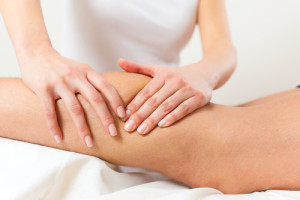
Complete Decongestive Therapy (CDT) is the standard treatment for lymphedema. Frequency of treatment varies. In the Unites States, a common frequency is 3x/week for 4 weeks but duration will vary depending on a person’s needs. If there is weeping (lymphatic fluid exuding from the skin), for example, daily treatment may be needed for a time to prevent tissue maceration. Treatment for Lymphedema typically includes:
1. Manual Lymph Drainage (“MLD”)
MLD is a gentle, manual massage administered in such a way to give the skin a two-way stretch & open the initial lymphatic vessels. Depending on a patient’s medical history, the massage sequence will vary. Fibrosis techniques are included in the massage to break up fibrotic tissue & facilitate drainage. The massage takes approximately 30 minutes depending on the extremities involved & the complexity of a patient’s presentation. Benefits of this massage include: Increased lymphangio-motoricity, increased lymph transport & a pain-relieving effect.
2. Compression Bandaging Compression bandaging usually involves 3-layers (a liner, cotton or foam & bandages). Bandaging is traditionally done with special short-stretch bandages. These look like ACE bandages but they are not the same. The application is important; if incorrectly applied, bandages can increase swelling. Bandages typically remain on until the next treatment session. Benefits of proper bandaging include: Improved muscle-pump efficiency; prevention of lymph fluid re-accumulating in areas where it has been drained; breaking up of fibrosis, connective tissue & scar tissue deposits.
3. Skin Care
Education is given on how to care for the health of the skin. Topics covered often include infection prevention & recognition, appropriate cleansing & lotion products as well as application & nail care.
4. Exercise
Patients are instructed in appropriate home exercises to facilitate volume reduction. This typically includes range of motion, diaphragmatic breathing & strengthening. Exercises may also be done during the treatment session.
5. Self-Care Instruction & Garment Fitting
Throughout treatment, education will be given preparing the patient for successful transition after discharge in managing their condition. At the end of treatment, compression garments are needed to maintain volume loss attained during treatment. A person will be fitted with the appropriate garment during the middle or end of their treatment. In cases where garments are not affordable or insurance coverage or reimbursement is questionable, creative approaches may be designed for a person, if possible.
When treatment is done, it is recommended that a 6-month follow up be scheduled to monitor volume & to assess garments, ensuring they are still in good condition.
Note: A medical professional skilled in administering CDT will have attended a specialized school for no less than 135 hours. Training involves instruction in the lymphatic system (anatomy & physiology, lymphedema pathology, complete decongestive therapy, treatment contraindications & an extensive hands-on lab). Weekend courses do not qualify a professional to treat lymphedema. Attempting to treat a person who has lymphedema without proper training will not only be ineffective, it could be dangerous for a patient, especially when there are co-morbidities such as heart or kidney dysfunction.
